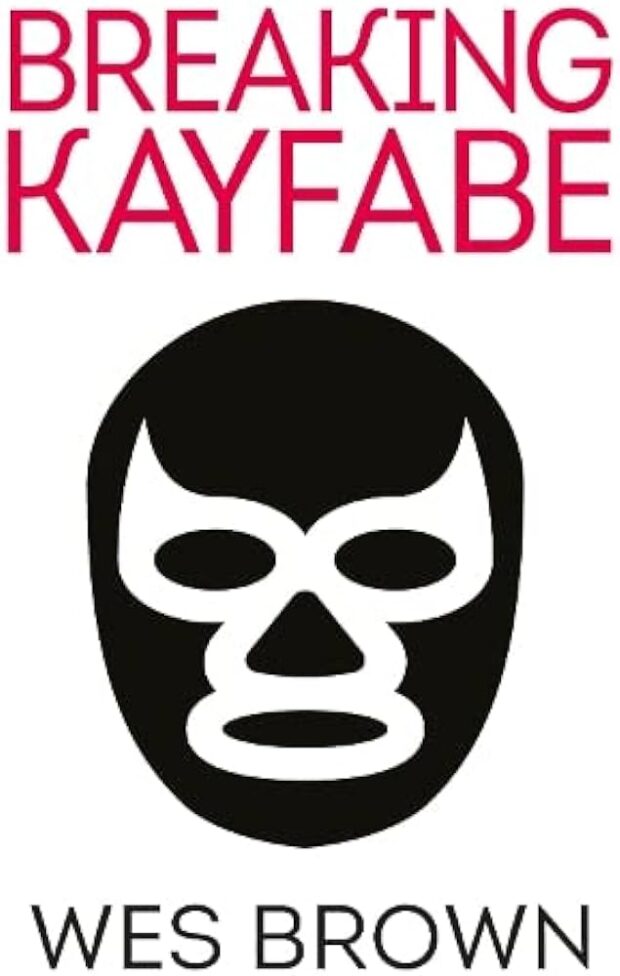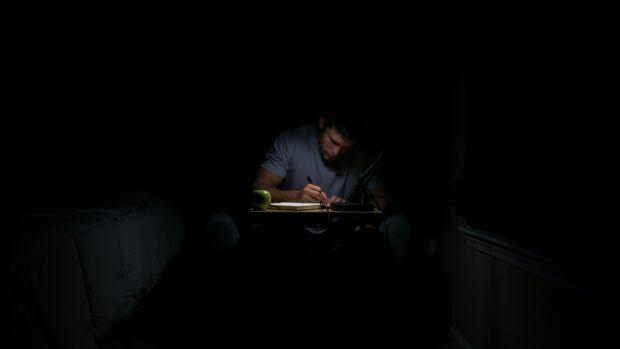You have no items in your cart. Want to get some nice things?
Go shopping
The male body is an object of fascination in Breaking Kayfabe, Wes Brown’s shapeshifting autofiction on his unlikely career in UK pro wrestling. We begin with the narrator as a child observing his sleeping father, the real-life 1970s wrestling legend ‘Sailor’ Earl Black. Wes looks down on “the wreckage of his body,” his “washed up bulk.” One leg is fused stiff, part of his spine is missing, his “muscular canvas” is painted with faded tattoos, and his teeth float in a glass of water.
Brown poignantly captures the dual sensation of awe and disgust which the child feels on seeing old bodies. Through these eyes there is something mythic and heroic in the broken body. Only an adoring son could see this type of masculinity and dream of becoming it – which, of course, Wes does.
Men’s bodies in this book, like their minds, are battered and bruised, often intentionally. It illuminates the reality of the strange “mythic realm of wrestling”: men throwing themselves around for other people’s – usually other men’s – entertainment. Reading the book, you realise how little this type of masculinity is seen in modern literature and wider culture.
Skip ahead to Brown in his late twenties, after a stalled literary career and an identity crisis, and Breaking Kayfabe sees him live out the childhood dream of following in his father’s Spandex.
The product of four years of real-life wrestling, followed by four years of writing, this is an impressive and distinctive work. Its indie publisher, Hebden Bridge-based Bluemoose Books, is home to the 2019 bestseller Leonard and Hungry Paul by Rónán Hession and was the original publisher of Benjamin Myers’ Pig Iron, earning it glowing write-ups in The Guardian as “a small but mighty literary hit factory.” Brown’s book deserves to be among Bluemoose’s best read and most lauded of the year.
Breaking Kayfabe follows a familiar arc as Brown’s character goes on the journey from a rookie wrestler, or “strawb,” to becoming a UK champion, in the process cultivating his persona as a baddy, or “heel.” The bulk of the story is told in the backroom and in the ring at wrestling shows, with fight scenes which are dramatic, fun, and accessible, and depictions of Brown’s fellow wrestlers full of humanity and humour.
So far, so usual. But the text handles these wrestling tropes in such a considered, thoughtful way that it takes the reader deep into the subculture’s psychology; the effect is enthralling. Bodies sustain real injuries in staged fights. Outside of the ring, wrestling caricatures take over their hosts. To ask if wrestling is real or fake is to ask the wrong question. The right question is, why do we invest so much in fictions and what does it do us?
For Brown’s character, wrestling and writing are inextricable from his sense of self. He writes, “I was always convinced I was never enough and always had to reach to be something else, something that wasn’t me and that was the way to be successful.”
So, this is a book as much about writers and writing as it is about wrestlers and wrestling. Breaking Kayfabe is billed as Brown’s debut novel, but some will recall an ill-fated proto-debut in his early twenties. Ill-fated because he cultivated a “contrarian intellectual” persona which felt false, and he spent time on the literary circuit feeling like “a coward, an imposter” and “a liar, a bullshitter, a charlatan.” This is raw stuff. There is real honesty and pathos in the image: the lost young man who presents a façade to the world, feels a fraud, turns to drink, and implodes.
Contrast that with the assured and grounded writing on the page in Breaking Kayfabe. Brown cleverly allows the reader to draw parallels between the “Strong Style” he seeks in wrestling – a more physical, combative style compared to light-touch staging – and the strong style he aims for in writing. Brown never defines that literary ‘strong style’ for the reader, he leaves it on the page. But we are told that “I had lost faith in novelly novels. In their fake plots, fake events, fake characters.” The prose is no-nonsense, never elevated and overly stylised, nor style-less or macho. This is high-impact prose, unflinching, emotive, and crisp. The preciseness within sentences and across the whole structure is a credit to the writer and editors. And in a text where style constitutes identity, the author’s ongoing search to find their voice has never been so vital.
The parallels between wrestling and writing continue in the middle-lands of kayfabe and autofiction. In wrestling, kayfabe exists in a creative space between fake and real, as the wrestlers code of illusion; in literature, autofiction occupies that obscure place between fact and fiction, or within both. All this metafiction and autofiction could be wearying, if it wasn’t handled so adeptly and set within an irresistibly simple rookie-to-champion arc.

Wrestling drives the story in this book, it’s the source of the protagonist’s dreams and the stage for Brown’s philosophy on masculinity and much else. But he also invites us to see it as a foil, a MacGuffin. Alongside his “Earl Black Jr gimmick,” he writes of creative writing lecturing as his “Mr Brown gimmick.” Naturally, we wonder what constitutes his ‘dad’ gimmick, his ‘boyfriend’, his ‘son’ gimmick. The word gimmick, here, does some unusually heavy lifting in terms of the masks we wear. If every role and relationship in our lives is a mask of sorts, then what of our identity? He writes:
“It was becoming difficult to tell where I ended and Earl Black Jr began, but I didn’t care. I liked feeling his black blood in my veins, like a poison, a Venom symbiote I had invented, made up of parts of myself I had repressed.”
This brings us back to the point of men and their place in the world, or as Brown puts it, our “fictions of masculinity.” Brown writes objectively of how “macho was crude and backwards” and how wrestling gave some men the outlet to perform their fantasies of masculinity. Ultimately, the narrator journeys out of the myth, having come through his childhood awe, seen past the heroic image of his father, and decided that “I didn’t want to live with any more illusion than I had to.”
Brown navigates all this smartly in a fast-paced, entertaining read, leaving the reader with questions and impressions which last long beyond the final page.
Breaking Kayfabe by Wes Brown, Bluemoose Books, May 2023, 290 pages.

Want to try your own hand at autofiction? Know how to write from lived experience, and turn memories into stories?
Sign up now to “Writing Your Truth”: a two-week masterclass with award-winning and Women’s Prize for Fiction Futures shortlisted novelist, Jessica Andrews.
About Jonny Aldridge
Jonny Aldridge is a writer based in northeast England. His journalism and fiction have appear in Litro, 3:AM, Sabotage Reviews, and New Escapologist, among others.




